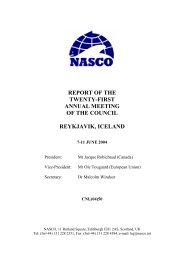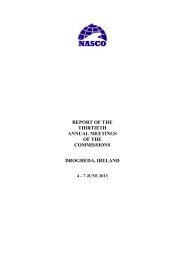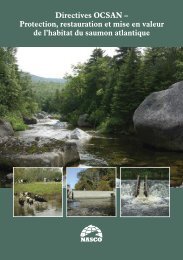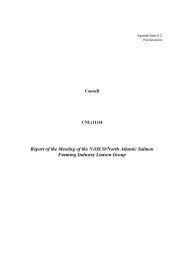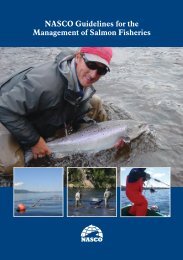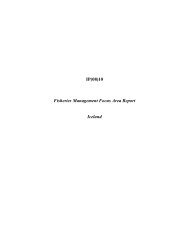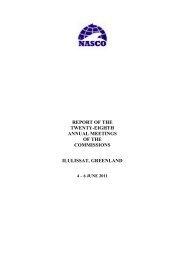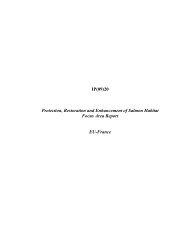Report of the 2005 ICES/NASCO Symposium on Interactions ...
Report of the 2005 ICES/NASCO Symposium on Interactions ...
Report of the 2005 ICES/NASCO Symposium on Interactions ...
You also want an ePaper? Increase the reach of your titles
YUMPU automatically turns print PDFs into web optimized ePapers that Google loves.
NINA SPECIAL REPORT 34<br />
differences in hydrography could cause changes in sea lice<br />
dispersi<strong>on</strong> that radically altered risks to wild fish.<br />
Differences between emerging dispersi<strong>on</strong> models in<br />
Norway and Scotland were briefly discussed.<br />
R<strong>on</strong> Stagg had posed <str<strong>on</strong>g>the</str<strong>on</strong>g> questi<strong>on</strong> <str<strong>on</strong>g>of</str<strong>on</strong>g> whe<str<strong>on</strong>g>the</str<strong>on</strong>g>r any<strong>on</strong>e had<br />
determined <str<strong>on</strong>g>the</str<strong>on</strong>g> impacts <str<strong>on</strong>g>of</str<strong>on</strong>g> sea lice <strong>on</strong> wild fish<br />
populati<strong>on</strong>s. Bengt Finstad attributed this to <str<strong>on</strong>g>the</str<strong>on</strong>g> lack <str<strong>on</strong>g>of</str<strong>on</strong>g><br />
systematic investigati<strong>on</strong>, a deficiency currently being<br />
addressed through <str<strong>on</strong>g>the</str<strong>on</strong>g> collaborative research project with<br />
industry, recently initiated in <str<strong>on</strong>g>the</str<strong>on</strong>g> Hardangerfjord system.<br />
Tom Cross also appeared to have anticipated <str<strong>on</strong>g>the</str<strong>on</strong>g> questi<strong>on</strong><br />
<str<strong>on</strong>g>of</str<strong>on</strong>g> impacts <str<strong>on</strong>g>of</str<strong>on</strong>g> sea lice <strong>on</strong> wild fish populati<strong>on</strong>s but<br />
explored qualitative changes at <str<strong>on</strong>g>the</str<strong>on</strong>g> genotype and<br />
phenotype level ra<str<strong>on</strong>g>the</str<strong>on</strong>g>r than numerical changes. They<br />
examined impacts <str<strong>on</strong>g>of</str<strong>on</strong>g> diseases associated with farming <strong>on</strong><br />
genetic variability <str<strong>on</strong>g>of</str<strong>on</strong>g> sea trout from two systems, <str<strong>on</strong>g>the</str<strong>on</strong>g> Erriff<br />
and <str<strong>on</strong>g>the</str<strong>on</strong>g> Burrishoole. Archived scale samples were<br />
examined and variati<strong>on</strong>s at both a locus critical to<br />
immune resp<strong>on</strong>se (MHC1) and six neutral microsatellite<br />
loci were measured. Two c<strong>on</strong>trasting situati<strong>on</strong>s were<br />
found: in <str<strong>on</strong>g>the</str<strong>on</strong>g> Erriff, decreases in genetic variability were<br />
found in both MHC1 and <str<strong>on</strong>g>the</str<strong>on</strong>g> neutral markers. By<br />
c<strong>on</strong>trast, later samples from <str<strong>on</strong>g>the</str<strong>on</strong>g> Burrishoole showed a<br />
recovery in MHC1 variability. Evidence was presented to<br />
show differences between <str<strong>on</strong>g>the</str<strong>on</strong>g> two systems in <str<strong>on</strong>g>the</str<strong>on</strong>g> relative<br />
proporti<strong>on</strong>s <str<strong>on</strong>g>of</str<strong>on</strong>g> sea trout to freshwater-resident fish, with<br />
proporti<strong>on</strong>ally much higher numbers <str<strong>on</strong>g>of</str<strong>on</strong>g> freshwaterresident<br />
trout in <str<strong>on</strong>g>the</str<strong>on</strong>g> Burrishoole.<br />
Chrys-Ellen Neville presented a paper <strong>on</strong> <str<strong>on</strong>g>the</str<strong>on</strong>g> effects <str<strong>on</strong>g>of</str<strong>on</strong>g><br />
fish farm lice <strong>on</strong> wild pink salm<strong>on</strong>. Large numbers <str<strong>on</strong>g>of</str<strong>on</strong>g> pink<br />
salm<strong>on</strong> smolts emigrate through <str<strong>on</strong>g>the</str<strong>on</strong>g> Queen Charlotte<br />
Strait, an area <str<strong>on</strong>g>of</str<strong>on</strong>g> intense Atlantic salm<strong>on</strong> farming activity.<br />
Data from a recent year class was presented, showing that<br />
adult pink salm<strong>on</strong> returned in unusually high numbers <str<strong>on</strong>g>the</str<strong>on</strong>g><br />
following year but it was not possible to c<strong>on</strong>clude<br />
whe<str<strong>on</strong>g>the</str<strong>on</strong>g>r this was due to <str<strong>on</strong>g>the</str<strong>on</strong>g> Provincial Acti<strong>on</strong> Plan which<br />
introduced a fallowed migrati<strong>on</strong> corridor, or increased<br />
freshwater flow, which could lead to c<strong>on</strong>diti<strong>on</strong>s less<br />
favourable to sea lice producti<strong>on</strong>, or o<str<strong>on</strong>g>the</str<strong>on</strong>g>r factors.<br />
Ano<str<strong>on</strong>g>the</str<strong>on</strong>g>r sessi<strong>on</strong> <str<strong>on</strong>g>the</str<strong>on</strong>g>me was sea lice c<strong>on</strong>trol. Current<br />
health management practices <strong>on</strong> Scottish salm<strong>on</strong> farms<br />
were discussed by Graeme Dear. Bacterial problems<br />
were shown to be largely under c<strong>on</strong>trol due to vaccines,<br />
resulting in major reducti<strong>on</strong>s in <str<strong>on</strong>g>the</str<strong>on</strong>g> use <str<strong>on</strong>g>of</str<strong>on</strong>g> antibacterial<br />
compounds. Viral diseases remained a serious c<strong>on</strong>cern,<br />
recent ISA outbreaks having largely been c<strong>on</strong>trolled <strong>on</strong>ly<br />
through rigorous culling. Management measures, in<br />
combinati<strong>on</strong> with access to good medicines, have been<br />
critical in reducing sea lice levels <strong>on</strong> farms, although more<br />
effort is required by some sectors <str<strong>on</strong>g>of</str<strong>on</strong>g> <str<strong>on</strong>g>the</str<strong>on</strong>g> industry. A key<br />
message was <str<strong>on</strong>g>the</str<strong>on</strong>g> threat posed by <str<strong>on</strong>g>the</str<strong>on</strong>g> emergence <str<strong>on</strong>g>of</str<strong>on</strong>g> new<br />
disease challenges, but also flagged up were <str<strong>on</strong>g>the</str<strong>on</strong>g> potential<br />
<str<strong>on</strong>g>of</str<strong>on</strong>g> genetic selecti<strong>on</strong> to improve disease resistance, <str<strong>on</strong>g>the</str<strong>on</strong>g><br />
emerging field <str<strong>on</strong>g>of</str<strong>on</strong>g> nutraceuticals, and <str<strong>on</strong>g>the</str<strong>on</strong>g> c<strong>on</strong>tinued<br />
importance <str<strong>on</strong>g>of</str<strong>on</strong>g> applicati<strong>on</strong> <str<strong>on</strong>g>of</str<strong>on</strong>g> best practice to avoid<br />
disease.<br />
Trends in <str<strong>on</strong>g>the</str<strong>on</strong>g> use <str<strong>on</strong>g>of</str<strong>on</strong>g> medicines in <str<strong>on</strong>g>the</str<strong>on</strong>g> Norwegian salm<strong>on</strong><br />
farming industry were presented by Kari Grave. This<br />
presentati<strong>on</strong> focused <strong>on</strong> <str<strong>on</strong>g>the</str<strong>on</strong>g> questi<strong>on</strong> <str<strong>on</strong>g>of</str<strong>on</strong>g> whe<str<strong>on</strong>g>the</str<strong>on</strong>g>r <str<strong>on</strong>g>the</str<strong>on</strong>g><br />
current use <str<strong>on</strong>g>of</str<strong>on</strong>g> antimicrobials and anti-sea lice medicines in<br />
particular posed any threat to wild fish. While it was<br />
c<strong>on</strong>cluded that <str<strong>on</strong>g>the</str<strong>on</strong>g>re were no toxicological risks, suboptimal<br />
treatments against sea lice promoted heavy lice<br />
infestati<strong>on</strong>s and increased infecti<strong>on</strong> pressure <strong>on</strong> emigrating<br />
Atlantic salm<strong>on</strong> smolts. At <str<strong>on</strong>g>the</str<strong>on</strong>g> opposite extreme, overreliance<br />
<strong>on</strong> certain key medicines increased <str<strong>on</strong>g>the</str<strong>on</strong>g> risk <str<strong>on</strong>g>of</str<strong>on</strong>g><br />
development <str<strong>on</strong>g>of</str<strong>on</strong>g> resistance with c<strong>on</strong>sequent welfare<br />
c<strong>on</strong>cerns and increased risks to wild fish. Ove Skilbrei<br />
assessed whe<str<strong>on</strong>g>the</str<strong>on</strong>g>r treatment <str<strong>on</strong>g>of</str<strong>on</strong>g> ranched Atlantic salm<strong>on</strong><br />
against sea lice with orally administered emamectin<br />
benzoate prior to release affected survival. Survival did<br />
not differ between treatment and c<strong>on</strong>trol groups released<br />
in May, but <str<strong>on</strong>g>the</str<strong>on</strong>g>re was a two-fold increase in survival in<br />
treated compared with untreated fish released in June.<br />
Moreover, treated fish were almost <strong>on</strong>e third heavier. It<br />
was also c<strong>on</strong>cluded that sub-lethal lice levels may affect<br />
growth and, <str<strong>on</strong>g>the</str<strong>on</strong>g>refore, size at spawning and fecundity <str<strong>on</strong>g>of</str<strong>on</strong>g><br />
wild fish.<br />
The use <str<strong>on</strong>g>of</str<strong>on</strong>g> cleaner wrasse to c<strong>on</strong>trol sea lice <strong>on</strong> farmed<br />
fish was reviewed by Per Gunnar Kvenseth. The<br />
presentati<strong>on</strong> informed <str<strong>on</strong>g>the</str<strong>on</strong>g> audience <str<strong>on</strong>g>of</str<strong>on</strong>g> <str<strong>on</strong>g>the</str<strong>on</strong>g> efficacy and<br />
cost-effectiveness <str<strong>on</strong>g>of</str<strong>on</strong>g> using wrasse to c<strong>on</strong>trol sea lice in<br />
commercial farm situati<strong>on</strong>s and <str<strong>on</strong>g>the</str<strong>on</strong>g> recent advances in<br />
breeding <str<strong>on</strong>g>of</str<strong>on</strong>g> ballan wrasse in particular. He c<strong>on</strong>cluded that<br />
wrasse should be c<strong>on</strong>sidered as part <str<strong>on</strong>g>of</str<strong>on</strong>g> an integrated sea<br />
lice management strategy.<br />
Data sharing, trust and cooperati<strong>on</strong> am<strong>on</strong>g regulators,<br />
farmers and wild fish interests are <str<strong>on</strong>g>the</str<strong>on</strong>g> foundati<strong>on</strong>s<br />
essential to any effective management c<strong>on</strong>trol strategy.<br />
The achievements <str<strong>on</strong>g>of</str<strong>on</strong>g> <str<strong>on</strong>g>the</str<strong>on</strong>g> Scottish Tripartite Working<br />
Group approach to this were reviewed by Phil Gilmour.<br />
Organisati<strong>on</strong>al aspects at nati<strong>on</strong>al, regi<strong>on</strong>al and local levels<br />
were explained. Success was judged in terms <str<strong>on</strong>g>of</str<strong>on</strong>g> <str<strong>on</strong>g>the</str<strong>on</strong>g><br />
degree <str<strong>on</strong>g>of</str<strong>on</strong>g> c<strong>on</strong>sensus that had been achieved, <str<strong>on</strong>g>the</str<strong>on</strong>g> number<br />
<str<strong>on</strong>g>of</str<strong>on</strong>g> Area Management Groups that had been formed and<br />
Area Management Agreements that had been signed.<br />
57



